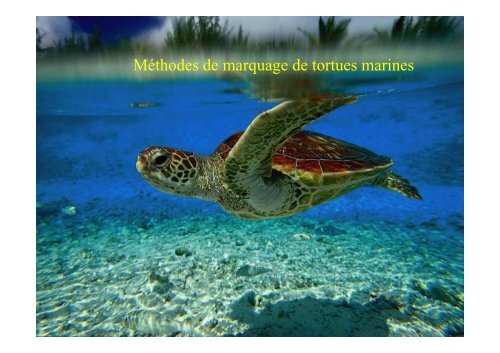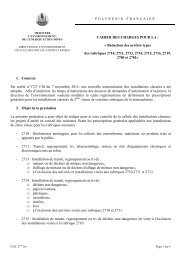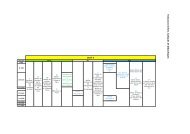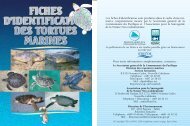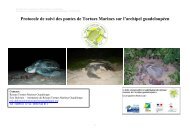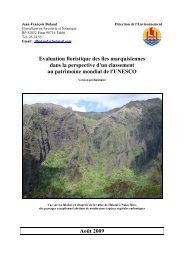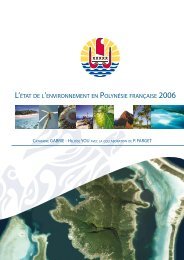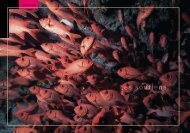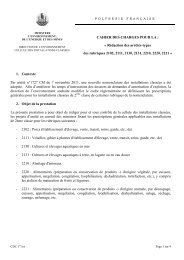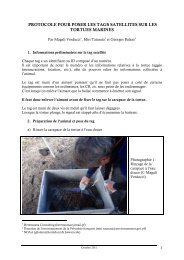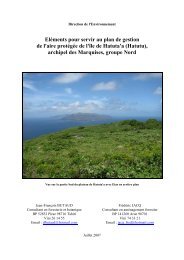You also want an ePaper? Increase the reach of your titles
YUMPU automatically turns print PDFs into web optimized ePapers that Google loves.
<strong>Métho<strong>de</strong></strong>s <strong>de</strong> <strong>marquage</strong> <strong>de</strong> tortues marines<br />
Année 2011
Pourquoi baguer les tortues?<br />
Le <strong>marquage</strong> fournit <strong>de</strong>s informations<br />
sur les divers aspects biologiques <strong>de</strong>s<br />
tortues (reproduction, croissance, taille<br />
<strong>de</strong>s populations et migration)
Différentes techniques <strong>de</strong><br />
<strong>marquage</strong><br />
Avantages et inconvénients
Pose <strong>de</strong> bagues<br />
- Technique la plus utilisée car la<br />
moins onéreuse<br />
- Existence <strong>de</strong> # types <strong>de</strong> bagues<br />
(plastique, métal)
Modèle en métal<br />
- modèle américain dit « monel »<br />
- modèle australien en titanium
Figure 1. Size and shape of Monel tag style 1005-49 and Inconel style 1005-681, manufactured by<br />
National Band and Tag Company (http://www.nationalband.com/nbtear.htm). Tag card photo courtesy<br />
NMFS-SEFSC.
Modèle en plastique<br />
facile à poser<br />
mais<br />
s’accroche facilement dans<br />
tous les obstacles<br />
lecture <strong>de</strong>s bagues rendue<br />
difficile par les algues qui se<br />
développent
Modèle en plastique<br />
Figure 2. Size and shape of plastic “Jumbo” Rototags and their placement on (a) an adult female loggerhead<br />
(Photo: Scott Eckert/ WIDECAST) and (b) a juvenile green turtle (Photo: Bermuda Turtle Project).
Inscription sur la bague<br />
Figure 3. Enlarged view of the dorsal (alphanumeric) and ventral (return address) faces of an Inconel<br />
1005-681 tag available from the Marine Turtle Tagging Centre (MTTC). Photo: Stacy Kubis/ WIDECAST.
Tronspon<strong>de</strong>ur ou <strong>marquage</strong> PIT<br />
Avantages<br />
- application simple<br />
- durée <strong>de</strong> vie non limitée<br />
- pas <strong>de</strong> symptôme <strong>de</strong> rejet<br />
- <strong>marquage</strong> international
Inconvénients<br />
- coût élevé<br />
- besoin d’un lecteur<br />
- incompatibilité <strong>de</strong>s systèmes<br />
existants<br />
- non lecture possible par tout<br />
public<br />
- possibilité <strong>de</strong> migration dans les<br />
tissus
Pose <strong>de</strong> transpon<strong>de</strong>ur<br />
Figure 10. Inserting a PIT tag into the front flipper of a juvenile sea turtle, showing both (a) ventral and (b)<br />
dorsal insertion points. Note the angle of the applicator to ensure that the tag is inserted just beneath the<br />
skin, not too <strong>de</strong>ep into the flipper. Note, as well, that taggers should be wearing gloves! Photos: (a)<br />
Bermuda Turtle Project; (b) Jeanette Wyneken/ Florida Atlantic University.
Lecteur <strong>de</strong> PIT<br />
Figure 9. Several brands, including the (a) AVID rea<strong>de</strong>r (http://www.ezidavid. com/avid_technology.htm)<br />
and (b) Destron Pocket Rea<strong>de</strong>r (Photo: NOAA/NMFS/SEFSC), utilise “multi-mo<strong>de</strong> technology” that<br />
enables them to read ID co<strong>de</strong>d <strong>de</strong>vices from various manufacturers.
Pose <strong>de</strong> PIT dans la nageoire<br />
arrière<br />
Figure 13. Inserting a PIT tag into the rear flipper of an adult green turtle. Note the angle of the applicator<br />
to ensure that the tag is inserted just beneath the skin, not <strong>de</strong>ep into the flipper. Photo: George Balazs/<br />
NOAA Hawai’i.
« Living tag »<br />
Figure 15. A green turtle with a living tag. On the plastron the tag appears as a dark spot (or streak) and<br />
on the carapace, as a light spot (or streak). Photos: Julia Horrocks/BSTP.
Où baguer ?
Figure 6. Metal flipper tag placed adjacent to the first large scale in the rear flipper of a green turtle.<br />
Source: Balazs (1999).
Les pinces<br />
Figure 8. A Monel 1005-49 style metal flipper tag correctly loa<strong>de</strong>d (left) and cinched (right) in the application<br />
pliers. ALWAYS align the base plate of the tag flat against the pliers. Note the tine bent over and<br />
completely through the stirrup. Source: http://www.nationalband.com/nbt.pdf
Pose d’émetteur satellite
En bref<br />
…<br />
- baguer chaque nageoire avant<br />
- si la tortue est déjà baguée,<br />
noter les références et envoyer un<br />
message à l’adresse indiquée
- si la tortue ne possè<strong>de</strong> qu’une<br />
bague, la noter et baguer l’autre<br />
nageoire<br />
- toujours examiner les 4<br />
nageoires avant <strong>de</strong> baguer la<br />
tortue<br />
- laisser un espace entre le bord<br />
<strong>de</strong> la nageoire et le côté incurvé<br />
<strong>de</strong> la bague
Quand doit-on rebaguer?<br />
- quand la bague est abîmée<br />
- quand la bague engendre une<br />
blessure<br />
- quand la bague est illisible
Attention<br />
- D’abord rebaguer avant<br />
d’enlever l’autre bague abîmée<br />
- Enregistrer le n° <strong>de</strong> bague et la<br />
retourner à l’adresse indiquée en<br />
indiquant les raisons
A quel moment du cycle <strong>de</strong><br />
reproduction?
Une fois que la tortue est en train<br />
<strong>de</strong> pondre


